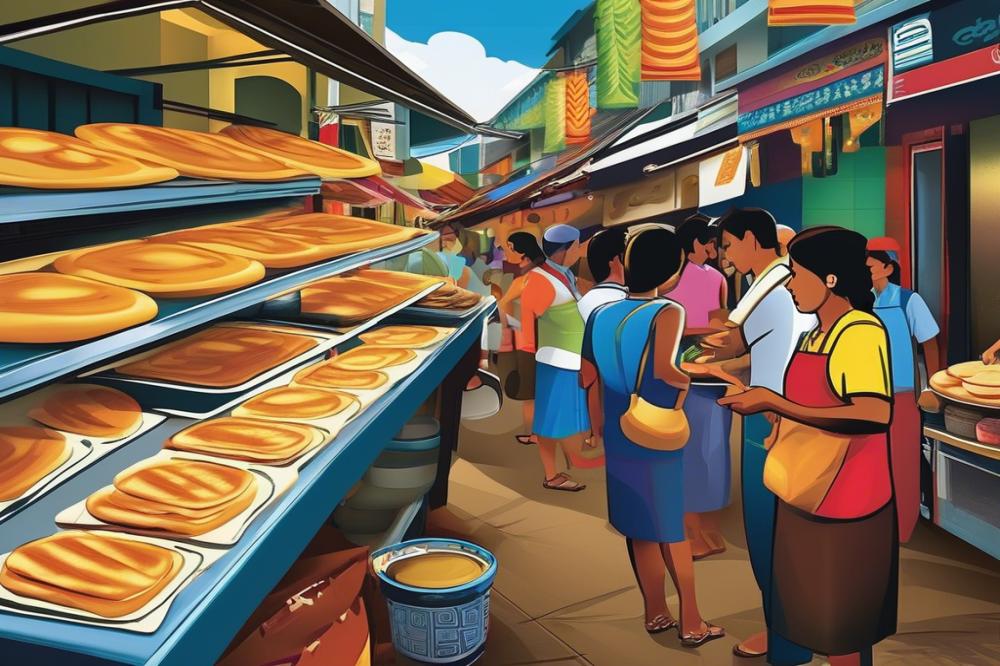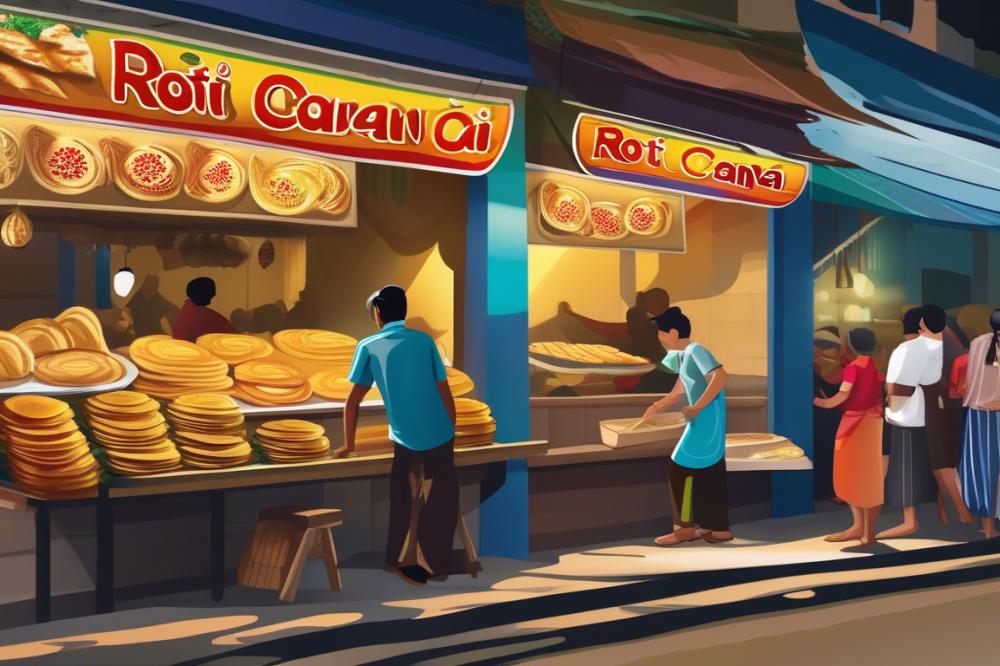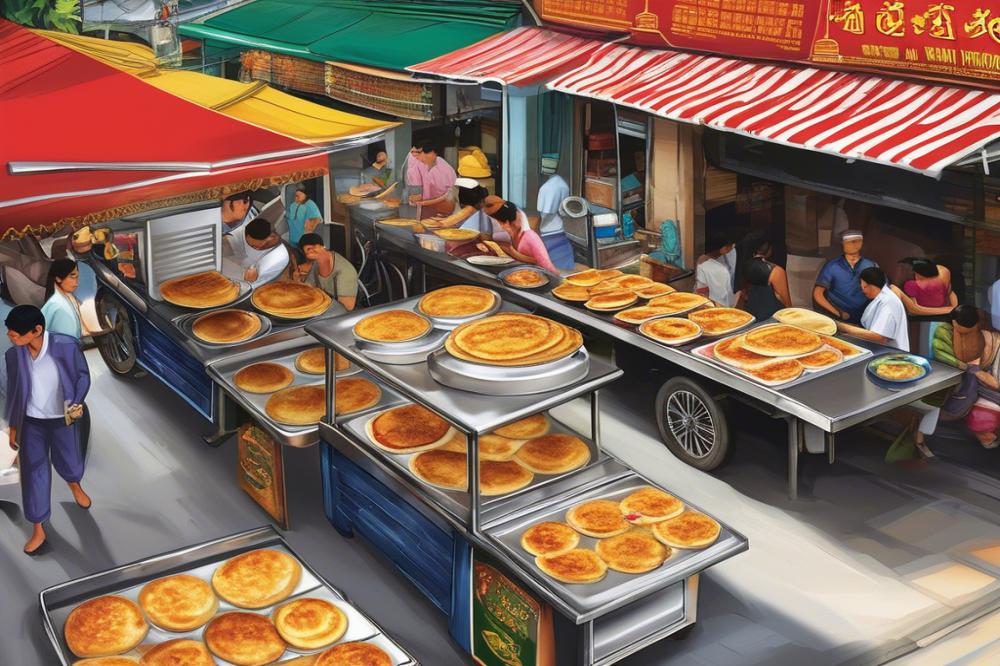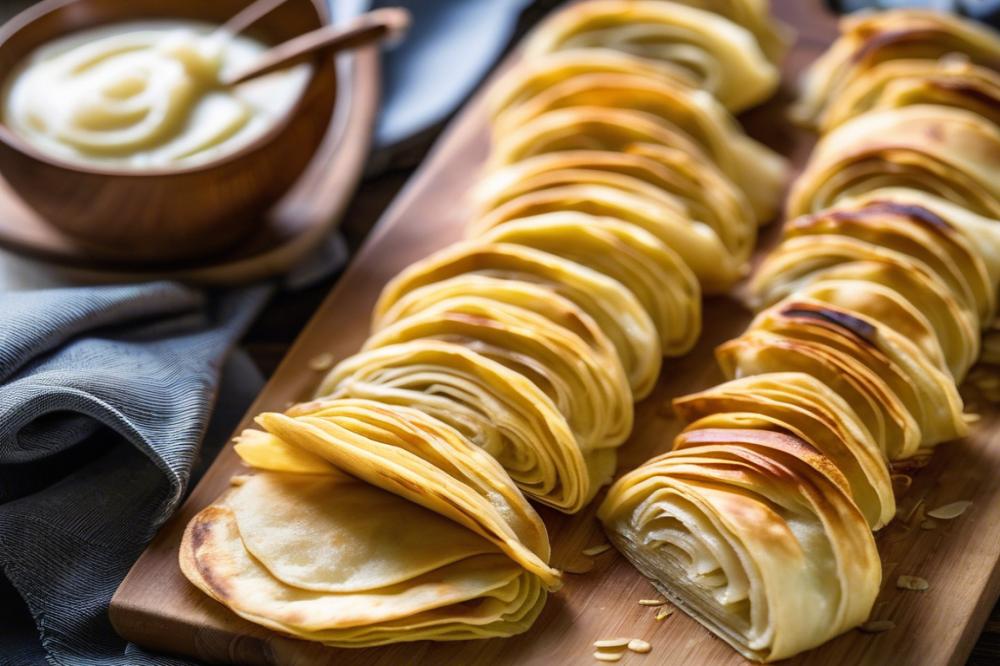recipebix.com/ayam-masak-merah-recipe-malaysian-red-cooked-chicken”>Roti Canai Recipe: flaky Malaysian Flatbread
Roti Canai is a beloved Malaysian Flatbread with a rich history. This flaky dish has become a staple in the vibrant world of street food culture in Malaysia. It offers both simplicity and depth, allowing the flavors to shine through. Many people enjoy this dish as a breakfast option, making it a versatile choice for any meal of the day.
Indian influence plays a significant role in the creation of Roti Canai. The preparation involves unique techniques that have been adapted and embraced by Malaysian cuisine. Street vendors often serve this delicious flatbread with an array of sauces and curries, adding to its appeal. This cooking method keeps the dish exciting and accessible to everyone.
As a breakfast item, a Roti Canai recipe proves to be easy to follow. With just a few simple ingredients, anyone can make it at home. The layers of dough create the characteristic flakiness that makes this flatbread so special. Many enjoy it with sweetened condensed milk or spicy curry, enhancing its diverse flavor profile.
In essence, Roti Canai is not just food; it represents a culinary tradition that connects people across cultures. Its significance in the daily lives of Malaysians cannot be overstated. Friends and families gather at roadside stalls, sharing this delightful dish and creating unforgettable memories.
Roti Canai: A Flaky Malaysian Flatbread

Roti Canai is a popular Malaysian flatbread that enthusiasts often enjoy at breakfast or as street food. This dish shows strong Indian influence, reflecting the cultural blend found in Malaysia. To the untrained eye, it may appear simple, yet its preparation is an art form.
The textural experience of Roti Canai is its most remarkable feature. Made using a layered dough, it becomes delightfully flaky and crispy when cooked. Chefs achieve this by skillfully stretching and folding the dough multiple times, creating pockets of air and layers as it bakes on a hot griddle.
Countless variations exist to cater to different tastes. Some people prefer their flatbread served with a variety of curries, making every bite more flavorful. Others enjoy sweet versions, such as those filled with bananas or sugar. The versatility of this dish invites creativity, allowing for a range of ingredients to suit any palate.
This versatile recipe not only appeals to locals but also attracts tourists eager to sample authentic flavors. By learning the cooking method, anyone can replicate this flaky delight at home. The simplicity of the ingredients, usually consisting of flour, water, and ghee, allows for easy preparation, making it accessible to all.
Ingredients and Cooking Method

Detailed Ingredients List
To make this flaky Malaysian flatbread, gather the following ingredients:
- 3 cups all-purpose flour
- 1 tsp salt
- 1 tbsp sugar
- 1 cup water (adjust as needed)
- 1 cup condensed milk
- 2 tbsp ghee or unsalted butter
Nutritional Information
Understanding the nutritional value of each ingredient can help you appreciate the dish more:
- All-purpose flour: A source of carbohydrates, providing energy.
- Salt: Essential for flavor but should be consumed in moderation.
- Sugar: Adds a bit of sweetness, generally around 16 calories per tablespoon.
- Water: Vital for hydration, no calories.
- Condensed milk: Rich in calories, providing sweetness and creaminess.
- Ghee or unsalted butter: Adds fats and richness, with approximately 100 calories per tablespoon.
Cooking Instructions
Follow these steps for preparing your dough:
- In a large bowl, mix together the all-purpose flour, salt, and sugar.
- Gradually add the water and condensed milk while stirring. Adjust the amount of water based on the flour’s consistency.
- Knead the dough for about 10 minutes until it’s smooth and elastic. This is crucial for achieving that perfect texture.
- Cover the dough with a damp cloth and let it rest for at least 2 hours. This step helps in developing the gluten.
Techniques for Achieving Flakiness
To create that signature flaky texture, here are a few tips:
- After resting, divide the dough into small balls, about the size of a golf ball.
- With your palms, flatten each ball and use your fingertips to stretch it outwards. Aim for a very thin layer.
- Once the dough is thin, brush the surface lightly with ghee or butter, then fold it in thirds to create layers.
- Roll it into a coil or spiral shape. Allow it to rest for another 30 minutes to an hour. This resting period is essential for achieving flakiness.
Tips for Cooking on a Skillet or Griddle
Cooking roti canai is just as important as preparing the dough:
- Preheat a non-stick skillet or griddle over medium heat; this allows for even cooking.
- Place the folded dough on the skillet and cook until golden brown on one side, about 2-3 minutes.
- Flip the flatbread to cook the other side. You can press down with a spatula for even cooking.
- For a crispy texture, you can brush more ghee on the edges while cooking.
- Serve hot with your favorite curry or even as part of breakfast. This street food favorite can be enjoyed any time of day.
Serving Suggestions and Accompaniments

Common Ways to Serve Roti Canai
Roti canai is a delightful flatbread that shines as street food in Malaysia. It is commonly enjoyed during breakfast, yet versatile enough to be served at any meal. Many people like to tear the bread apart, making it easier to share and enjoy. Plating the flaky, golden-brown bread on a simple white dish highlights its crispy texture. Often, diners will order a stack, with each piece ready to be dipped in sauces or served alongside curries.
Popular Dipping Sauces
A classic accompaniment is dhal, a spiced lentil curry that complements the flatbread perfectly. Many enjoy the rich, creamy texture as it melds with the layers of roti. Another popular sauce is chicken curry, which features tender pieces of meat simmered in a flavorful broth. Fish curry or mutton curry also make excellent choices. The spices in these dips add a punch, making each bite more enjoyable. Some people even prefer simple sugar or condensed milk for a sweet twist.
Ideas for Filling Variations
Filling variations can transform this dish into something unique. For a savory twist, try adding minced meat or chopped vegetables inside the dough. Spinach and cheese create a satisfying blend that delights the taste buds. Sweet options are just as enticing. Imagine biting into a flaky bread stuffed with bananas and drizzled with honey. The contrast of flavors and textures is truly enjoyable. Whether savory or sweet, the right ingredients can elevate the experience, making each meal a memorable one.
The Cultural Significance of Roti Canai
Roti Canai’s Role in Malaysian Breakfast Culture
Breakfast in Malaysia often starts with this flaky flatbread. Many people enjoy it alongside a cup of strong coffee or tea. Some prefer it with dhal, a lentil curry, while others savor it with sugar. Variations exist, but the essence remains the same. Its presence on breakfast tables reflects the nation’s diverse culinary landscape. Families may gather at hawker stalls or cafés, indulging in this delicious meal. It represents a blend of tradition and convenience.
Exploration of its Popularity as Street Food
Street vendors serve this versatile snack to eager customers every day. Locals flock to these stalls for a quick bite. The cooking method is often fascinating to watch. Skilled cooks stretch the dough expertly, creating layers that lead to a crispy exterior. People love the crispiness paired with spicy curry. This flatbread is not just food; it embodies the love for simple, flavorful meals. For many, grabbing Roti Canai is a cherished ritual, a quick pleasure in their busy lives.
Reflection on its Indian Roots and Adaptations in Malaysia
Indian influence plays a significant role in the creation of this dish. Originating from South Indian cuisine, it has evolved over time. While retaining its core ingredients, adaptations have emerged. Malaysian versions incorporate local flavors and spices, making it unique to the region. Cooks experiment with fillings, from savory to sweet. Each variation tells a different story, showcasing local creativity. This blend of cultures reflects Malaysia’s rich heritage and the fusion of cuisines that define its food scene.
Wrapping Up the Delight of Roti Canai
This flaky Malaysian flatbread has captured the hearts of many. Its layers create a delightful texture that is both crispy and chewy. When you dip it into curry or serve it with a side of sambal, the flavors come alive in a way that is truly satisfying. The appeal lies not just in its taste, but also in its fascinating history and method of preparation.
Why not take a chance and try making this dish at home? Experimenting in the kitchen can be a rewarding experience. Following a simple recipe allows you to discover the joy of creating something delicious from scratch. Gather some ingredients, roll up your sleeves, and dive into the art of crafting your own Roti Canai.
Lastly, remember that this dish is not limited to just one way of serving. You can fill it with sweet or savory items to suit your taste. Whether you enjoy it plain, with sugar, or paired with a rich curry, the options are plenty. The enjoyment you find in it is what makes it special. Embrace the versatility of this wonderful flatbread and celebrate the pleasure it brings to your meals.



